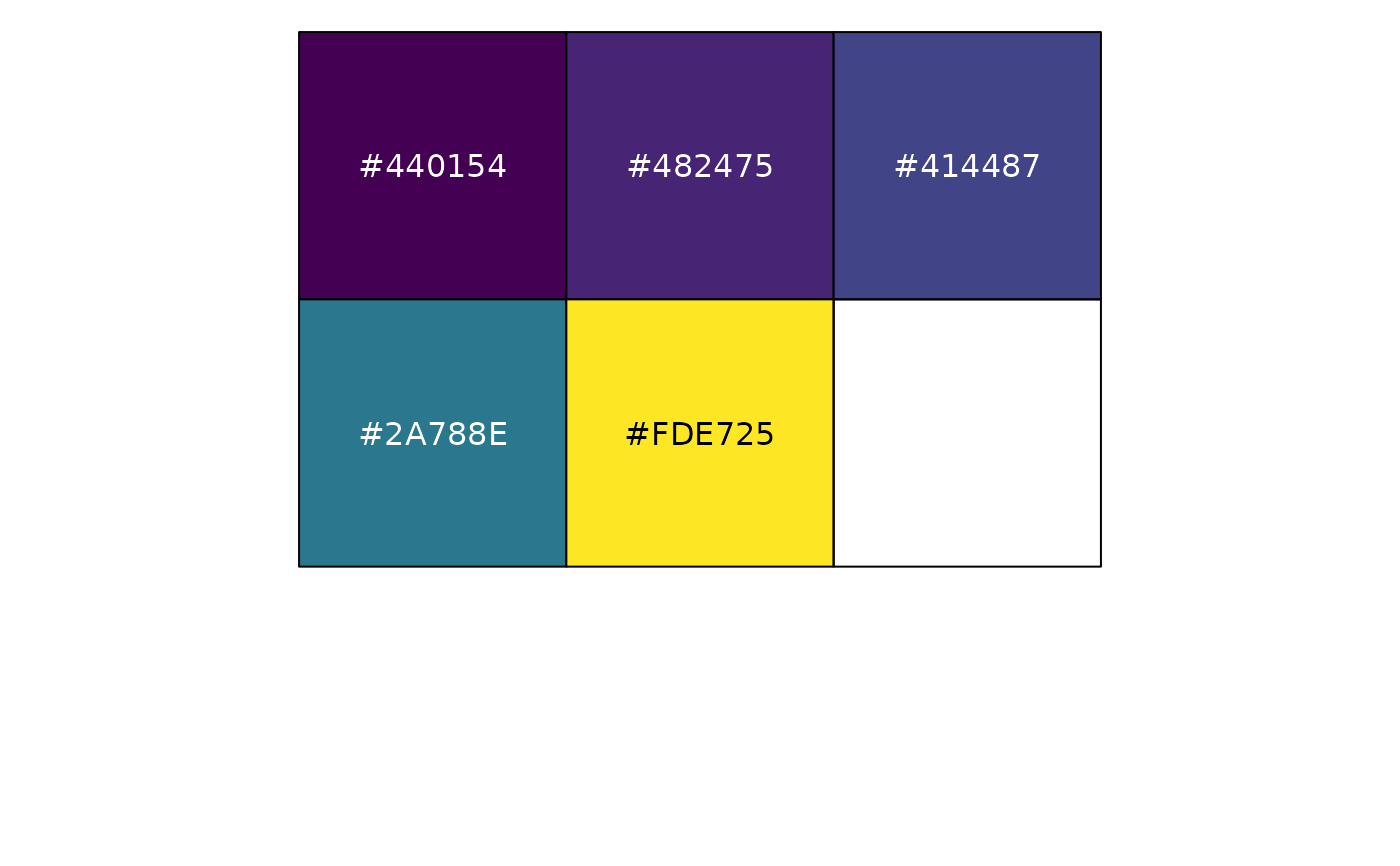These constructor functions attach metadata to palette functions. This metadata can be used in testing or coercion.
new_continuous_palette(fun, type, na_safe = NA)
new_discrete_palette(fun, type, nlevels = NA)
is_pal(x)
is_continuous_pal(x)
is_discrete_pal(x)
is_colour_pal(x)
is_numeric_pal(x)
palette_nlevels(pal)
palette_na_safe(pal)
palette_type(pal)
as_discrete_pal(x, ...)
as_continuous_pal(x, ...)Arguments
- fun
A function to serve as a palette. For continuous palettes, these typically take vectors of numeric values between (0, 1) and return a vector of equal length. For discrete palettes, these typically take a scalar integer and return a vector of that length.
- type
A string giving the type of return values. Some example strings include
"colour","numeric","linetype"or"shape".- na_safe
A boolean indicating whether
NAvalues are translated to palette values (TRUE) or are kept asNA(FALSE). Applies to continuous palettes.- nlevels
An integer giving the number of distinct palette values that can be returned by the discrete palette.
- x
An object to test or coerce.
- pal
A palette to retrieve properties from.
- ...
Additional arguments. Currently not in use.
Value
For new_continuous_palette(), new_discret_palette(), as_discrete_pal()
and as_continuous_pal(): a function of class pal_continuous or pal_discrete.
For is_pal(), is_continuous_pal(), is_discret_pal(), is_colour_pal(),
or is_numeric_pal(): a logical value of length 1.
For palette_nlevels() a single integer. For palette_na_safe() a boolean.
For palette_type() a string.
See also
Examples
# Creating a new discrete palette
new_discrete_palette(
fun = grDevices::terrain.colors,
type = "colour", nlevels = 255
)
#> function (n, alpha, rev = FALSE)
#> {
#> if ((n <- as.integer(n[1L])) > 0) {
#> k <- n%/%2
#> h <- c(4/12, 2/12, 0/12)
#> s <- c(1, 1, 0)
#> v <- c(0.65, 0.9, 0.95)
#> alpha <- if (missing(alpha) || is.null(alpha))
#> NULL
#> else rep_len(alpha, n)
#> cols <- c(hsv(h = seq.int(h[1L], h[2L], length.out = k),
#> s = seq.int(s[1L], s[2L], length.out = k), v = seq.int(v[1L],
#> v[2L], length.out = k), alpha = alpha[seq_len(k)]),
#> hsv(h = seq.int(h[2L], h[3L], length.out = n - k +
#> 1)[-1L], s = seq.int(s[2L], s[3L], length.out = n -
#> k + 1)[-1L], v = seq.int(v[2L], v[3L], length.out = n -
#> k + 1)[-1L], alpha = alpha[k + seq_len(n - k)]))
#> if (rev)
#> rev(cols)
#> else cols
#> }
#> else character()
#> }
#> <bytecode: 0x557763e87098>
#> <environment: namespace:grDevices>
#> attr(,"class")
#> [1] "pal_discrete" "scales_pal" "function"
#> attr(,"type")
#> [1] "colour"
#> attr(,"nlevels")
#> [1] 255
# Creating a new continuous palette
new_continuous_palette(
fun = function(x) rescale(x, to = c(1, 0)),
type = "numeric", na_safe = FALSE
)
#> function (x)
#> rescale(x, to = c(1, 0))
#> <environment: 0x557763e72180>
#> attr(,"class")
#> [1] "pal_continuous" "scales_pal" "function"
#> attr(,"type")
#> [1] "numeric"
#> attr(,"na_safe")
#> [1] FALSE
# Testing palette properties
is_continuous_pal(pal_seq_gradient())
#> [1] TRUE
is_discrete_pal(pal_viridis())
#> [1] TRUE
is_numeric_pal(pal_area())
#> [1] TRUE
is_colour_pal(pal_manual(c("red", "green")))
#> [1] TRUE
is_pal(transform_log10())
#> [1] FALSE
# Extracting properties
palette_nlevels(pal_viridis())
#> [1] 255
palette_na_safe(colour_ramp(c("red", "green"), na.color = "grey50"))
#> [1] TRUE
palette_type(pal_shape())
#> [1] "shape"
# Switching discrete to continuous
pal <- as_continuous_pal(pal_viridis())
show_col(pal(c(0, 0.1, 0.2, 0.4, 1)))
 # Switching continuous to discrete
pal <- as_discrete_pal(pal_div_gradient())
show_col(pal(9))
# Switching continuous to discrete
pal <- as_discrete_pal(pal_div_gradient())
show_col(pal(9))
